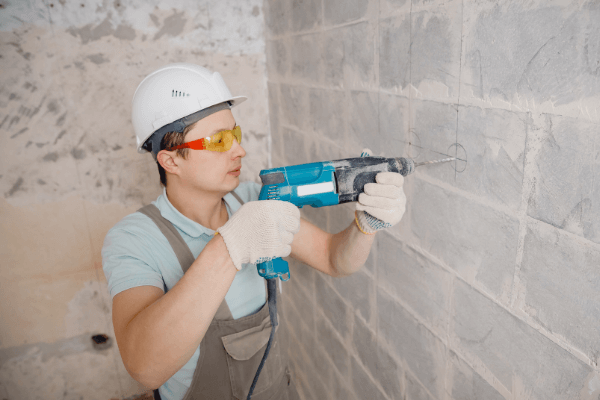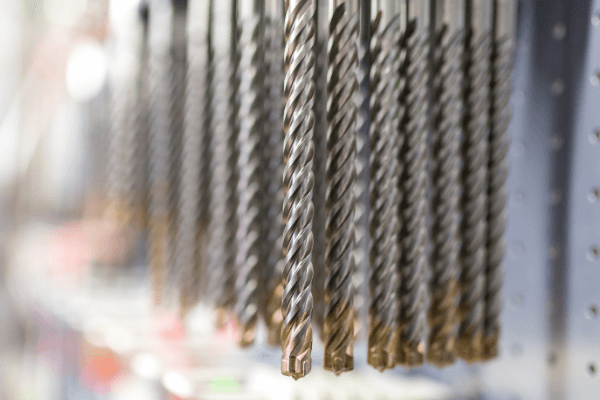
That said, — switch off the hammer action, and you’ll be able to tackle wood and other softer materials. So, as you can see, it’s a handy power tool for all kinds of projects.
Now I’ve got your attention. Let me take this opportunity to show you how straightforward this stonework supremo can be — in my step-by-step guide.
What You Will Need To Follow This Tutorial
Before we get down to the main event, here’s a list of what you need to use a hammer drill. Check you have everything before we get started.
- Hammer drill.
- Carpenter’s pencil.
- Ruler or measuring tape.
- Masking tape.
- Compatible drill bits.
- Traditional hammer.
- Masonry nail.
- Groundsheets.
- Face mask, ear, and eye protection.
- Can of compressed air.
- Vacuum.
How To Use a Hammer Drill — Step by Step Instructions
As I mentioned earlier, there are a number of uses for a hammer drill. Hence, to save this guide resembling War and Peace, I’m going to walk you through one scenario — drilling a hole in concrete.
Step #1: Power Your Drill
First, you’ll want to make sure your drill has power.
If you have a corded hammer drill, plug it in, and ensure that you can reach your workspace without fear of pulling out the power cable.
For cordless hammer drill use, make sure the battery is fully charged beforehand.
Step #2: Prepare Your Workspace and Yourself
- Check that the workspace and material you’re drilling into are clean and free of any debris that could get in your way.
Lay down tarps or groundsheets around your drilling area — debris can fly out and fall onto the surrounding floor.
- You should also make sure that your goggles and earplugs are securely attached to your face and won’t fall off during drilling. Don your face mask, and if you have long hair, tie it back.
- Ensure that you have enough space to stand comfortably.

Step #3: Marking Target Holes on the Drill Area
- Following the five P’s principle — proper planning prevents poor performance — it’s a good idea to mark out the position on the concrete where you plan to drill.
Take your time with this step, and double-check that the location is correct.
- While you have your ruler or measuring tape to hand, it’s also the ideal time to plan the drilling depth.
Some drills have a handy stop bar built into their design, but if yours doesn’t, simply note the depth on the drill bit with a piece of masking tape.

Step #4 : How To Set up and Use a Hammer Drill
How to use a hammer drill and marking holes
- Select the appropriately sized masonry drill bit for your hole, and make sure you lock it into place.
- Assume the correct drilling stance. When using a hammer drill, keep your feet shoulder-width apart, and make sure that they’re placed firmly on the ground. Grab the handle of the drill firmly with one hand — with your fingers wrapped around. Take your other hand and use it to support the back of the tool.
- Set about making a guide or pilot hole before going for the big push with full hammer action.
Position the drill bit so that it’s perpendicular to the surface and be prepared for some bounce back.
You want to work at a slow pace — hence, choose the lowest speed setting your hammer drill has to offer. If your device only has the option of on or off, you’ll need to drill in controlled, short bursts of no more than two seconds. Aim to drill to a depth of no more than 0.25 inches.
- Now you’re ready to drill the remainder of the hole. Reconfirm your stance and continue to apply firm pressure to the tool — and pull the trigger. You don’t need to apply too much pressure on the unit as the hammer action will do the majority of the work for you — after all, this is why you use a hammer drill.
- As your confidence grows, you can dial up the speed, but it’s not essential — slow and steady wins the race.
- Remove the drill from the hole every 15 seconds or so and brush away any dust.
- Once you have reached the marker on your drill bit, you can stop drilling. Take a can of compressed air and spray gently into the hole to push out any concrete dust.
- Repeat steps two to seven for any additional holes you require.
- Keeping your safety goggles and face mask in place, vacuum up all the residue from the surrounding area.
Handy Hints and Tips
- The concrete surface may have small stones or air pockets which will change the resistance against the bit. Be prepared and keep a firm grip on the tool and stay focused.
- Don’t force the drill if you hit an obstruction, it could cause irreparable damage to the bit or even the power tool itself. You need to know when to use a hammer drill and when to stop.
If you reach an area that seems impenetrable, take your hammer and a masonry nail and provide a few small taps to dislodge the hindrance.
Conclusion
Remember to take it slowly and prepare your markings properly. Similarly, ensure that you have a correct body position and a firm grip on the machine.
I hope you enjoyed this tutorial and now feel confident about how to use a hammer drill. If you have any more questions, let us know in the comments below, and give the article a share if you found the information helpful.











